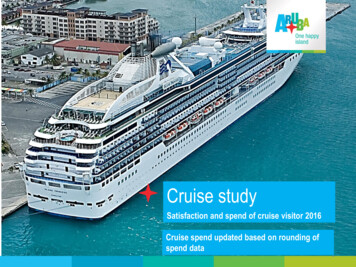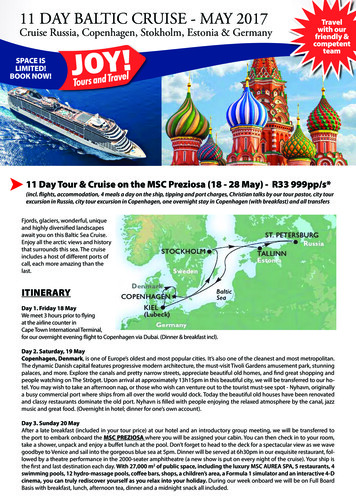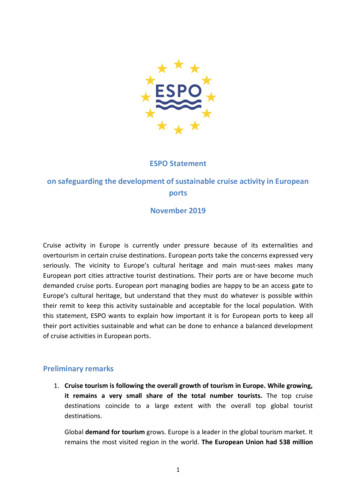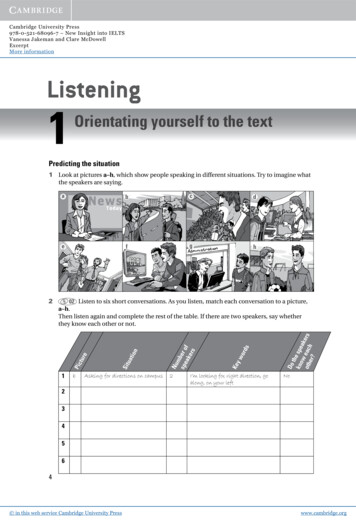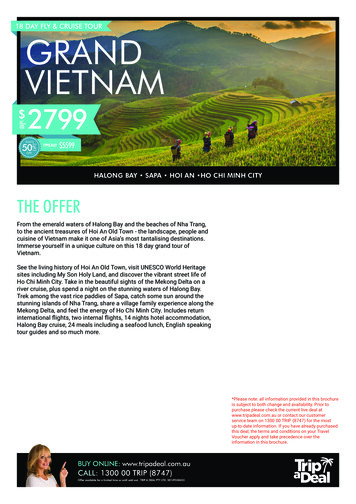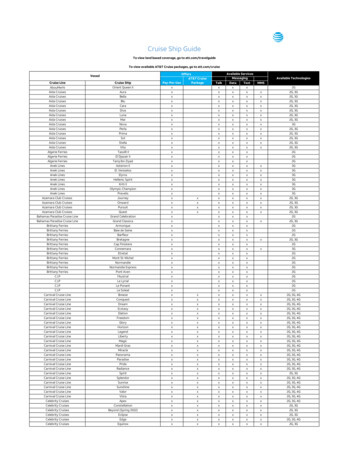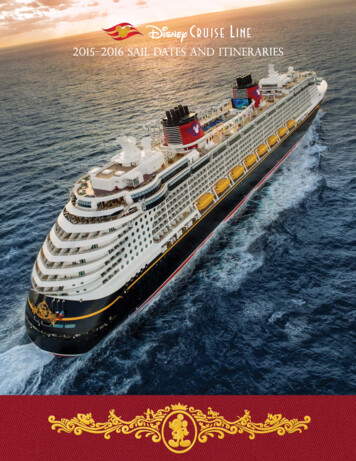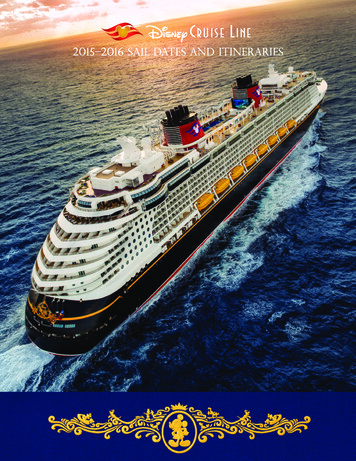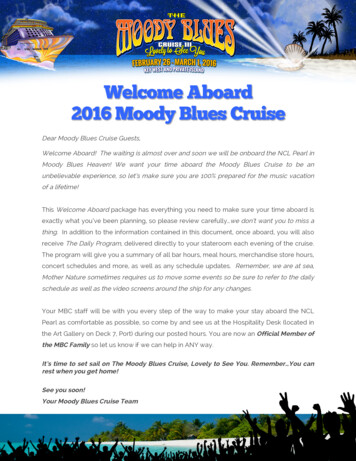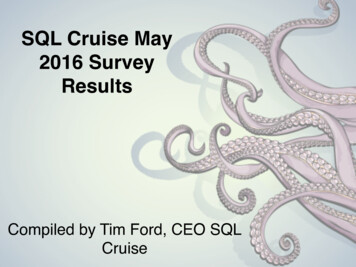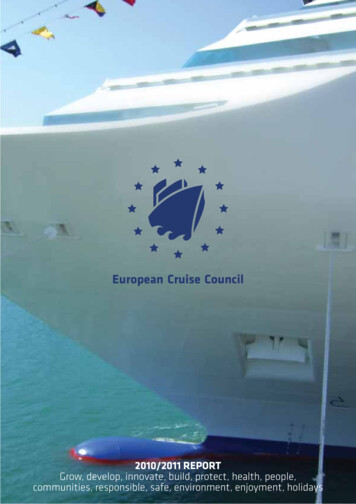
Transcription
European Cruise Council2010/2011 REPORTGrow, develop, innovate, build, protect, health, people,communities, responsible, safe, environment, enjoyment, holidays
Business or pleasure ?@V\ ZP[ H[ H [HISL PU H JVUMLYLUJL JLU[YL VU [OL [VW KLJR @V\ LUQV [OL THYP[PTL H[TVZWOLYL JVTIPULK P[O NYLH[ MHJPSP[PLZ ;OL ZOPW»Z Z[H[L VM [OL HY[ YLSPHISL PYLSLZZ 0U[LYUL[ HUK .:4 JVUULJ[PVU Z\P[Z V\ X\P[L ÄUL (UK MVY H TVTLU[ V\ VUKLY PZ [OPZ I\ZPULZZ VY WSLHZ\YL&@V\ HNYLL P[O V\YZLSM P[»Z IV[O @V\Y ZOPWZ 6\Y ZLY]PJL :OHYLK Z\JJLZZ 4HYP[PTL *VTT\UPJH[PVUZ 7HY[ULY ;VNL[OLY P[O THQVY : HUK ,\YVWLHU IHZLK JY\PZL IYHUKZ L WYV]PKL WHZZLUNLYZ P[O ºQ\Z[ SPRL OVTL» YLSPHISL .:4 * 4( HUK P-P ZLY]PJLZ 4*7 YHPZLZ [OL IHY MVY WHZZLUNLY HUK JYL ZH[PZMHJ[PVU I WYV]PKPUN ]HS\L HKKLK VUIVHYK JVTT\UPJH[PVU ZLY]PJLZ -VY TVYL PUMVYTH[PVU ]PZP[ V\Y LIZP[L TJW JVT VY JVU[HJ[ \Z H[! maritime communications partner
European Cruise Council 2010/2011 ReportForeword MANFREDI LEFEBVRE D’OVIDIOForewordThe European cruise industry continues to grow,along with the social and economic benefits itbrings to the region.Despite the global economic downturn thatprevailed, 2009 was another record-breakingyear for cruising in Europe. A record 4.9 million Europeanstook a cruise – 12% more than in 2008 – and most of themagain chose to travel within Europe, accounting for morethan 75% of the 4.8 million passengers (another record)embarking on their cruise at a European port.As well as those embarking, European ports also receivednearly 28 million visits by cruise passengers in transit (9% upon 2008) and a further 12.4 million by cruise ship crew.Spending by cruise lines, passengers and crew in thecourse of these cruises added to the corporate expenditureby cruise companies with European bases combined with thecontinued investment in new ships built at European yardsto produce a total impact on European economies of morethan 34 billion.This was 6% up on 2008 and is estimated, for the secondsuccessive year, to have outstripped the impact from theNorth American cruise sector on the US economy. As a result,cruising continued to support about 300,000 jobs acrossEurope.Back in 2005 the number of European cruise passengersstood at fewer than 3.3 million, embarkations at 2.8 millionand passenger visits at 13 million; while total economicimpact was 19 billion and the number of jobs supportedwas 187,000. By every measure, therefore, there has beensubstantial growth in just four years.It was because its founding cruise company membersforesaw this growth – and also identified a lack of awarenesswithin Europe of the sector’s value, importance and potential– that they set up the European Cruise Council (ECC) in 2004,and immediately began commissioning the economic impactstudies which have shined a light on the huge – and growing– contribution being made by cruising to national, regionaland local economies and communities.Among other objectives, the ECC has tasked itself with: working for the elimination of trade barriers and for anEU regulatory environment that will foster the continuedgrowth of the cruise sector in Europe; striving for an EU regulatory environment thatsupports safe shipping operations and protection ofthe environment and one that also recognises theinternational dimension of the sector and the rolesplayed by the International Maritime Organisation andInternational Labour Organisation in particular; raising the profile of the cruise sector with the EUinstitutions in relation to its economic and socialcontribution to Europe; and co-operating with EU institutions and non-governmentalorganisations in pursuit of these objectives whileanticipating and responding to policies and actions whichconflict with these objectives.Part of ECC’s self-imposed role in educating the widerworld about the industry in which its members operate,this magazine is designed not just to highlight its keyperformance indicators within Europe and place it withinthe context of the global cruise sector but also to providean insight into its structure and how it operates in differentcountries within Europe.At the same time it covers the issues and challenges theindustry faces, giving clear guidance as to the implicationsand possible consequences of recent and proposed futureregulations.We believe that such expert insight and informationcan positively contribute to ensuring that the growth of thesector continues, along with its contribution to Europe’seconomy.Manfredi Lefebvre D’OvidioEuropean Cruise CouncilChairman1
Intimate, ultra-luxury ships withonly 296 to 540 international guests Purpose-built expedition ship thatexplores the world from pole to pole.Six Ships. Seven Continents.Infinite Possibilities. Sumptuous, all ocean-view accommodations —most suites with private verandas Butler service for every suite Open-seating dining plus speciality restaurants Superb enrichment programmes that offer completeimmersion into the destination L’École des Chefs, the only Relais & Châteauxcooking school at sea Bespoke adventures off the beaten patharranged by the Silver Shore ConciergeSilversea ships navigate the world’s oceans, providing guests with unique cultural experiences and a deeper understanding of ourplanet. Silversea is committed to protecting and preserving the earth’s natural, historic and cultural treasures. Silversea also hasa profound appreciation and special dependence on the health of the world’s seas, and is devoted to ensuring the safe operationof their vessels by maintaining full compliance with international environmental regulations. Silversea proudly partners witha number of esteemed organisations that reflect the company’s goals for global compassion and conservation.Learn more about Silversea Cruises:visit Silversea.com contact 377.9770.2254 (Monaco)
European Cruise Council 2010/2011 ReportEuropean Cruise Council MISSION STATEMENTMission StatementThe aims of the European Cruise Council (ECC) are twofold. Firstly, to promote the interestsof cruise operators with the EU institutions in all matters of shipping policy and shipoperations. Secondly, to promote cruising by the European public and encourage expansionof the European cruise market. To that end the ECC will:ENCOURAGE high standards of operationRAISE the profile of the cruise sector withand the provision of high quality andthe EU institutions in relation to its economicefficient shipping services.and social contribution to Europe.STRIVE for an EU regulatory environmentPROMOTE cruising with the general publicthat supports safe shipping operations andand the travel trade as a reliable, affordableprotection of the environment, and thatand enjoyable holiday experience.recognises the international dimension ofthe sector and the roles played by IMO/ILOCOOPERATE with EU institutions and non-in particular.governmental organisations in the pursuitof these objectives.WORK for the elimination of barriersto trade and for an EU regulatoryANTICIPATE whenever possible, andenvironment that will foster therespond wherever appropriate,continued growth of the cruise sector into policies and actions which conflict withEurope.the above.5
A Passengership FleetThat Forges Ahead passengership routesISP delivers both the expertise and the experience to handle every aspect of managing andoperating your passengerships worldwide. For 20 years, we’ve been dedicated to providingthe most reliable, professional, and cost-effective solutions for your business, from passengerservice to maintenance to financials and anything else you or your clients may need.dedicatedpassengershipmanagementFor more information on ISP’s fleet of passengerships and accompanying management services,visit www.isp-usa.com or call us at 1 305 573 6355.
European Cruise Council 2010/2011 ReportExecutive interview PIERFRANCESO VAGOECC: an authoritative voiceto evaluate and explainThe European Cruise Council (ECC) has a role to playnot only in raising the profile of the cruise industrywith the regulators, public and consumers but alsoin enforcing standards of good behaviour amongits members, according to its Vice Chairman, MSCChief Executive Pierfranceso Vago.He cites as an example the fact that in the eyes of theconsumer “a great white ship is a great white ship” and thereis no perceived difference between their performance. Thismeans, he says, that the standard by which all members arejudged is by the least efficient.ECC is moving forward in its role of representing theEuropean cruise industry. “We are tackling issues dealingwith sulphur content, ECAs, discharge in the Baltic, Shipsanactivity,” he says. “ECC is here to ensure that members deliverclean tourism.”Health and hygiene, sanitation, accessibility to ships,package travel, new ships and security regulations arejust some of the other issues on the agenda. Many of thechallenges ECC faces are because there is a new generation ofvessels in the membership as well as older ones, he says.“Making the regulators aware of the challenges theindustry faces is one of ECC’s tasks, and another is tocommunicate to members about changes or improvementsthey can make to both older tonnage and existing ships, andto encourage the investment in tonnage for the benefit of theindustry itself.”Vago says the appointment by the ECC executive boardof Robert Ashdown as director of technical, operational andenvironmental matters, with a brief to drive these issuesforward, is an indication of ECC’s continued commitmenttowards the environment – in which Europe takes the lead,according to Vago.Raising the industry’s profile in Europe is important,though the cruise industry has an advantage because it canpoint to impressive statistics on the economy and is more‘romantic’ than certain other parts of the shipping world.One of the key issues, Vago says, is to ensure that ECCis in a position to put its views on proposals to regulate thecruise industry at an early enough stage. “Often there is a lotof discussion in Brussels and nobody is aware of it. Once adirective is issued by Brussels there is no longer the possibilityof intervention. This is where ECC wants to be very proactive.“The main task for ECC today is to be there as it happens,and when it is discussed,” Vago says.It is very important that ECC is the body the regulatorscontact when they wish to approach the industry, because ECCis in the best position to evaluate the industry’s needs andchallenges.One issue is the Baltic. “I think ECC has done an excellentjob so far, but it is complicated.” All ECC members recognisethat the Baltic Sea is an environmentally sensitive region, andall companies work hard to meet and beat all internationaland regional regulations. To operate in as environmentallyfriendly manner as possible, however, cruise operators needthe littoral states to invest in upgrading their port wastereception facilities so that the standards these states requirecan be met.“Too often the industry sees new standards beingproposed for which the technology does not yet exist,” saysVago. Another problem is that many of the problems the BalticSea faces are essentially the result of land-based activities;but the countries concerned find it easier to target shipping –even when its environmental impact is minimal – than to haveto fund expensive solutions within their own economies.Vago feels that this is another role that ECC can fulfil inBrussels. “If there is good coordination between members,different members can intervene at government level,” hesays. “There are opportunities to share information betweencompanies, including information on technical innovations.” Q“Too often the industry sees new standards being proposedfor which the technology does not yet exist.”Pierfranceso Vago, Vice Chairman, European Cruise Council and Chief Executive,MSC Cruises7
NORWAYthe ultimate natural cruise experienceNorway’s long coastline of 1300 nautical miles providesimmense possibilities for creative, interesting itinerariesin all seasons. Today, cruise ships call on about 30different Norwegian ports, with about 1478 calls in2010 and nearly 2 million visitors. Norway is the leadingnature based cruise destination in Europe.Associatedmember ofCheck out our cruise calendar atwww.cruise-norway.no.
European Cruise Council 2010/2011 ReportContentsContentsForewordManfredi Lefebvre D’Ovidio, Chairman, EuropeanCruise Council1ShipbuildingInnovation the key for shipbuilders555Computational fluid dynamics at the heart ofnew ship designECC Mission statement58ECC: an authoritative voice to evaluate and explainPierfranceso Vago, Vice Chairman, European CruiseCouncil and Chief Executive Officer, MSC Cruises7Hull and stern designs improve aerodynamics60Operational EfficiencyWhat is the power solution for stringent emissioncontrols?61Overall energy balance leads to greater efficiency65Ship operating profile critical indicator of fuelefficiency66AssociationsCLIA and ECC: developing a unified industry approachto regulation12Growth & OutlookGlobal cruise market15European economic impact: 34.2 billion20The conundrum over the supply of distillate fuelto reduce emissions67Source markets and deployment trends23Improving the control of HVAC68UK cruise market28German cruise market30Waste management is as important for portsas ships69Italian cruise market32French cruise market36Safety & SecuritySafety and security: a cooperative undertaking70Spanish cruise market38ClassificationMonitoring innovation and compliance72Selective European growth markets39HealthThe impact of Shipsan project on ports and ships74PortsCruise lines and cruise ports77Ports: recycling and improving facilities79Funding cruise port infrastructure8284Executive InterviewINTERCRUISES: upholding service excellence in themidst of international expansion40ShipbuildingProspects for European cruise shipbuilding42EnvironmentWorking to protect the environment44European Cruise Council environment statement45Executive InterviewSpadoni: eager for standardisation of portsProtecting the environment47Consumer Affairs: Keeping on top of health87Corporate initiatives in the environmental sector48Accessibility: seeking a workable solution to acomplex issue88ECC seeks harmonisation on EU Directive91Highlights from selected cruise companysustainability reports539
2JQVQ D[ ,COGU 2QTVQNorwegian Epic – Cruising Re-Imagined0QTYGIKCP 'RKE VCMGU QWT UKIPCVWTG (TGGUV[NG %TWKUKPI VQ C PGY NGXGN 1WT NCTIGUV CPF OQUVKPPQXCVKXG UJKR VQ FCVG TGFGƂ PGU EJQKEG CPF ƃ GZKDKNKV[ YKVJ OQTG VJCP FKPKPI QRVKQPU DCTU CPF NQWPIGU CPF PGXGT DGHQTG UGGP GPVGTVCKPOGPV CV UGC KPENWFKPI VJG YQTNF HCOQWU NWG /CP )TQWR CPF VJG VJGCVTKECN FKPKPI GZRGTKGPEG %KTSWG &TGCOU &KPPGT P CFFKVKQP 0QTYGIKCP 'RKE HGCVWTGU CP COC\KPI #SWC 2CTM YKVJ VJTGG YCVGT UNKFGU 0GY 9CXG UVCVG TQQOU YKVJ EWTXGF YCNNU CPF EQPEGCNGF EQPVQWT NKIJVKPI VJG NCTIGUV URC CPF Ƃ VPGUU EGPVTG CV UGC CPF 0QTYGIKCP %TWKUG .KPGnU OQUV NWZWTKQWU UWKVG EQORNGZ 6JKU KU (TGGUV[NG %TWKUKPI CV KVU DGUV CPF KVnU EQOKPI VQ VJG /GFKVGTTCPGCP KP UWOOGT YYY PEN GW
European Cruise Council 2010/2011 ReportContentsRegulationImplications of an evolving regulatory environment92Tax hike prompts Alaska downturn93The HELCOM initiative94Emissions and ECAs – the issues96Member profiles99AIDA Cruises100Azamara Club Cruises101Carnival Cruise Lines102Celebrity Cruises103Costa Cruises104Croisières de France105Cunard Line106Delphin Group107Disney Cruise Line108Fred. Olsen Cruise Lines109Holland America Line110Hapag-Lloyd Cruises111Hurtigruten112Iberocruceros113Louis Cruises114MSC Cruises115Norwegian Cruise Line116P&O Cruises117Phoenix Reisen118Princess Cruises119Pullmantur120Regent Seven Seas Cruises121Royal Caribbean International122Saga Shipping Company123Silversea Cruises124Star Clippers125Thomson Cruises/Island Cruises126TUI Cruises127Associate members128European Cruise Council2010/2011 REPORTGrow, develop, innovate, build, protect, health, people,communities, responsible, safe, environment, enjoyment, holidaysAshcroft & Associates, the publisher of the European CruiseCouncil 2010/2011 Report, would like to express their sincerethanks and gratitude to the many organisations thathave helped in the production of the Report by supplyingstatistics, facts and figures, information, photographs, orprovided help in other ways.We have made every effort to ensure the accuracy of theinformation but changes occur incessantly. Readers areadvised to check that any material facts are still currentwith the responsible authorities.For further information about the European Cruise Council2010/2011 Report please email:info@ashcroftandassociates.comor tel: 44 20 8994 4123The contents of this publication are protected bycopyright. All rights reserved.Published by Ashcroft & Associates LtdPO Box 57940,London W4 5RD, United Kingdomwww.ashcroftandassociates.comPublisher & EditorChris AshcroftContributorsTony PeisleySandra SpearesJohn McLaughlinGiuliana AlvinoDesign & ProductionRay Heath DesignOffice ManagerLucy LeachPrinted byWyndham Grange11
12European Cruise Council 2010/2011 ReportAssociations GLOBAL PARTNERCLIA and ECC: developinga unified industry approachto regulationAclose relationship is developing between theEuropean Cruise Council (ECC) and US-basedCruise Lines International Association (CLIA).And that bond is best understood by lookingat developments in the US, where the cruiseindustry had its origins – as many of those drivers were to befundamental in the creation and subsequent expansion of ECC.CLIA was formed in 1975 specifically to promote the specialbenefits of the cruise industry, which was growing fast fromits late-1960s origins in Florida.There was however a strong European connection eventhen, as pioneering brands such as Norwegian CaribbeanLines and Royal Caribbean Cruise Line were created througha combination of Scandinavian maritime expertise and USmarketing nous.In 1984 CLIA took on a new role as the main bodyresponsible for educating North American travel agents aboutcruising and training them to sell the fast-expanding range ofcruise products. Since then, as cruising has developed into aglobal industry, its training programmes have become a modelfor associations in other countries.In 2006 a sister organisation – the International Council of“Whether a ship is in the Mediterranean or the Caribbean anyissues affecting its operations will almost inevitably have aripple effect, with an impact on other ship operations aroundthe world.”CLIA President and CEO Terry Dale
European Cruise Council 2010/2011 ReportAssociations GLOBAL PARTNER“ECC was created at a time when the cruise industry wasbeginning to experience substantial growth in Europe. The issueswe saw coming to ECC were very similar to those facing CLIA, andhad to be addressed internationally or even globally.”Michael Crye, Executive Vice President, CLIACruise Lines, which was set up to participate in the regulatoryand policy development process of the cruise industry – wasmerged into CLIA. The result is that CLIA not only promotescruising and trains agents but it is also now fully responsible forcreating ‘a safe, secure and healthy’ cruise ship environment.It does this by ensuring that its members minimise theenvironmental impact of their ships’ operations on the ocean,marine life and destinations, and that they adhere to allregulatory initiatives and lead the effort to improve policiesand procedures.CLIA serves as a non-governmental consultativeorganisation in the International Maritime Organisation (IMO)and puts forward industry positions to key international aswell as domestic regulatory organisations and policymakers.It does this under the direction of its 25 member cruise lines,many of which are also members of ECC.“Whether a ship is in the Mediterranean or the Caribbean,”says CLIA President and CEO Terry Dale, “any issues affectingits operations will almost inevitably have a ripple effect, withan impact on other ship operations around the world.“That is why it is vitally important that we are on thesame page as ECC and other cruise associations emerging indifferent countries and regions.“We have to be talking to each other – and agreeing onpolicies – at the top level of the associations. It is our highestpriority – as it is the ECC’s – to collaborate on the global issues.“With so many important regulatory issues emerging frominternational, national and regional authorities, we must havea unified approach as an industry. It will help us, and also helpthe authorities, if we speak with one voice.“At CLIA we have 35 years’ experience and have built up agreat deal of technical expertise, and we want to share thataround the world.“We have worked closely with PSA and ACE to developtraining of agents, and we are happy to do the same withinother countries – although we recognise that one size does notalways fit all. But everything we have done can be adapted tolocal needs and different cultures.”CLIA Executive Vice President Michael Crye says: “ECC wascreated at a time when the cruise industry was beginning toexperience substantial growth in Europe. The issues we sawcoming to ECC were very similar to those facing CLIA, and hadto be addressed internationally or even globally.“As we have done for some time with the Florida–Caribbean Cruise Association and Northwest CruiseAssociation, we now collaborate with ECC to achievecommunality of purpose. This works through keeping thelines of communication open at all times. ECC can attend ourmeetings, and we are invited to theirs.“ECC has become plugged into our environmental andtechnical committees, while we are copied in to all theircommunications to their membership (and vice versa).”CLIA represents the industry at IMO, while ECC is beingdeveloped to do the same with the European Commission(EC) and other EU Institutions. ECC also interfaces with theLondon-based organisations – the International Chamber ofShipping and the International Federation of Shipping.“The move to set up a separate ECC organisation basedin Brussels at the heart of the EC, appoint a public relationsconsultancy and recruit a highly qualified environmental andtechnical director (Robert Ashdown) from the UK Chamberof Shipping shows how ECC is strengthening its position byincreasing its resources,” says Crye. “CLIA obviously welcomesthis.”He points to a variety of issues on which CLIA and ECCare benefiting from working together. They include the ECinitiative to introduce a similar ship sanitation inspectionprogramme to the one that has operated for many years inthe US; the move from a paper-based to an electronic systemfor clearing ships crew and passengers as they enter and leavedifferent countries; and the move to make the Baltic Sea a‘special area’.“The European Community has an increasingly influentialvoice in IMO and it is consequently important that the viewsof the global industry are heard and promoted in the Europeancontext,” says ECC Policy Director Tim Marking. “Closecooperation between ECC and CLIA is therefore essential.“It has also become clear that there are a number ofspecific EU policy areas which are of direct interest to thecruise sector, and where a strong and effective ECC in Brusselsis vital. As a result ECC has set up sub-committees on whichexperts from member lines bring their expertise to key issuessuch as health and hygiene, ports, environment, tourism andconsumer affairs and taxation.“Our aim is to work closely and constructively with theEU institutions and other stakeholders to try to ensure inparticular that the European regulatory framework is onewhere the cruise industry can continue to prosper in Europe.” Q13
European Cruise Council 2010/2011 ReportGrowth & Outlook GLOBAL MARKETSGlobal cruise markethe number of global cruise passengers continues torise steadily, with the 2009 total of 17.5 million morethan 22% higher than in 2005. There was a slowdownin that growth during the recession-hit year of 2008,but even this started to accelerate again in 2009and – set against the actual decline in most other sectors of traveland tourism – once again reflected the cruise industry’s resilience,which has been demonstrated during previous downturns causedby outside geo-political events.TNorth America has stagnated in recent years, but themarket within the EU has rapidly increased so the 2009 totalwas nearly treble that of 1999’s 1.7 million. This growth hasalso been reflected in the shift in sourcing by members of theNorth America-based Cruise Lines International Association(CLIA), which carry more than 97% of all North Americancruise passengers. In 2000 90% of their carryings were NorthAmericans, but this has fallen to 75% with the majority of theother 25% now being sourced from Europe.Global source markets for ocean cruising 2005–2009Cruise brands worldwide – a breakdownAlthough industry growth has been primarily driven by theaggressive newbuilding programmes of the larger groupswhich – as a result – operate about 80% of global capacity,there is a healthy diversity of independently owned regional,national or niche brands which have ensured that passengersare being attracted from an increasingly broad age range andsocio-economic demographic.Passengers (million)20052006200720082009North AmericaEurope*Rest of the World**TotalYear-on-year 05.002.1017.507.9%*Includes estimates for Russia and Eastern European countries outside EU-27**Includes estimates for some markets in Asia and South AmericaSource: ECC, CLIA and the International Cruise Council AustralasiaBrands owned by the three largest cruise companies (mainsource market/s and ECC membership)North America continues to be the largest source marketfor passengers, but over the past five years Europe hasbecome increasingly important both as a source market and asa destination.CLIA passengers 92010*North ctedSource: CLIA“North America has stagnated in recentyears, but the market within the EU hasrapidly increased so the 2009 total wasnearly treble that of 1999’s 1.7 million.”Carnival Corporation & PlcAida (Germany – ECC)Carnival Cruise Lines (North America and Europe – ECC)Costa Cruises (Europe – ECC)Cunard Line (North America and Europe – ECC)Holland America Line (North America and Europe – ECC)Ibero Cruceros (Spain – ECC)P&O Cruises (UK – ECC)P&O Cruises AustraliaPrincess Cruises (North America and Europe)*Seabourn Cruise Line (North America and Europe)* Marketed by ECC member Carnival UKRoyal Caribbean Cruises Ltd (RCCL)Azamara Club Cruises (North America and Europe – ECC)Celebrity Cruises (North America and Europe – ECC)Croisières de France (France – ECC)Pullmantur (Spain – ECC)Royal Caribbean International (North America and Europe – ECC)TUI Cruises (Germany – ECC) – joint venture with TUI AGGenting Hong Kong (formerly Star Cruises Group)Norwegian Cruise Line (North America and Europe – ECC) –jointly owned with Apollo ManagementStar Cruises (Asia)Source: ECC15
16European Cruise Council 2010/2011 ReportGrowth & Outlook GLOBAL MARKETSKey brands owned by other companies and theirmain marketsNew ships currently on orderLineEEC membersDelphin/Hansa Kreuzfahrten (Germany)Disney Cruise Line (North America)Fred. Olsen Cruise Lines (UK)Hapag-Lloyd Cruises (Germany)Hurtigruten (Germany, North America, UK)Louis Cruise Lines (North America and Europe)MSC Cruises (Europe and North America)Phoenix Reisen (Germany)Regent Seven Seas Cruises (North America and UK)Saga Shipping: Saga Cruises/Spirit of Adventure (UK)Silversea Cruises (North America, UK/Europe and Australia)Star Clippers (North America and Europe)Thomson Cruises (UK)Selected non-ECC brandsCruises and Maritime Voyages (UK)Crystal Cruises (North America and UK)Happy Cruises (Spain)Hebridean Island (UK)NYK Cruises (Japan)Oceania Cruises (North America)Paul Gauguin Cruises (North America)Ponant Cruises (France, North America, UK)SeaDream Yacht Club (North America and Europe)Swan Hellenic (UK and North America)Transocean (Germany)Voyages of Discovery (UK and North America)Source: ECC/A.R.Peisley LtdThere are 20 firm orders for new ships to be delivered throughto 2014. These will add a further 60,000 berths to the market,at a combined value of more than 9 billion. There are alsoseveral other options or letters of intent which are likely to beactivated over the next 18 months.The two largest cruise companies – Carnival and RCCL –account for 14 of the orders, while 14 ships are also for ECCmember brands. Eight of the ships will have Europe as theirmain target market.Although the overall trend is to build larger ships withincreasing capacities, there are still several on order of smallor medium size which will help maintain the diversity of thecruise product offering across a worldwide fleet of more than350 ships.Nine of the ten largest brands, and 16 of the top 20 largestcapacity brands, are ECC members.2010RCICunard2011OceaniaAIDAPonant CruisesCarnivalSeabournDisney CruiseCostaCelebrity2012AIDAOceaniaDisney 4PrincessDueCost(million)Allure of the SeasQueen Elizabeth220,000/6,400 10/1092,000/2,092 10/10 900 500MarinaAIDAsolL’AustralCarnival MagicSeabourn QuestDisney DreamCosta FavolosaCelebrity Silhouette65,000/1,260 1/1171,000/2,644 4/1110,500/ 268 5/11130,000/4,631 5/1132,000/450 5/11124,000/4,000 1/11114,200/3,780 10/11122,000/3,150 10/11 530 380 150 565 200 850 510 698TBARivieraDisney FantasyCosta FascinosaCarnival BreezeMSC FantasticaTBA71,000/2,644 4/1265,000/1,260 5/12124,000/4,000 5/12114,200/3,780 5/12130,000/4,631 6/12140,000/4,087 6/12122,000/3,150 10/12 385 530 850 510 738TBA 698TBATBA139,000/3,6
again chose to travel within Europe, accounting for more than 75% of the 4.8 million passengers (another record) embarking on their cruise at a European port. As well as those embarking, European ports also received nearly 28 million visits by cruise passengers in transit (9% up on 2008) and a further 12.4 million by cruise ship crew.
